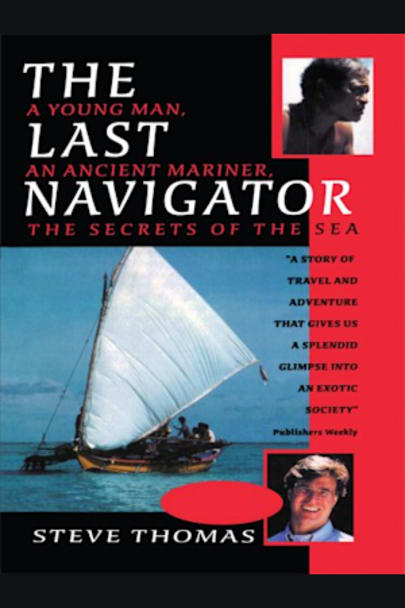As a young man piloting a small sailboat across the Pacific, Steve Thomas, host of Planet Green’s Renovation Nation, developed a fascination with ancient methods of navigation. He learned of a seafaring culture which, 6,000 years ago, used arcane navigation arts to guide initiates unerringly across the Pacific with no compasses, no charts. By the time of Christ, these navigators had populated … Oceania, nearly a quarter of the Earth’s surface. Thomas ventured to the tiny coral atolls of Micronesia in search of these mysteries, this ancient language of the sea. There he found the last navigator, Mau Piailug. One of the few surviving palu, he belongs to a dying breed who used only natural signs – stars, waves, birds – to guide their sailing canoes across thousands of miles of open ocean. Thomas and Piailug voyage together on the frail ship of human memory in an attempt to preserve for future generations an ancient, mysterious, and beautiful kinship with the sea before it is lost forever. Theirs is an unforgettable journey.
more



The Last Navigator by Stephen D. Thomas
In 1987, four years after his research began, Stephen D Thomas published his book The Last Navigator. It made quite a splash by recording some of the life and traditional navigational skills of Mau Piailug a Satawal Islander. Satawal is a remote raised coral island in what is now the Federated States of Micronesia. No more than a speck in a vast surrounding ocean, it lies 320 miles west of Truk and 430 miles south-south west of Guam. Mau Piailug was in his mid-fifties at the time, he was his island’s youngest Palu or fully initiated navigator. In 1970 Piailug had led his crew on a nine-hundred-mile round-trip voyage from Satawal to Saipan in his twenty-seven-foot proa. In 1976 he had become a hero when he guided the Hokule’a from Maui to Tahiti, and in 1980 he had made the voyage a second time – all without the aid of charts, compass nor instruments. The Last Navigator shows a slice of this man’s life and a well-researched look into the culture that spawned such navigational prowess.
Thomas spent about a year on Satawal and accompanied Piailug on several trips to neighboring islands. His documentation of Piailug’s skills is very thorough. The well-written 308-page book contains 54 pages of appendices, a glossary and an index. Thomas explains how Micronesian navigators use the rising and setting positions of fifteen stars or constellations to define thriry-two points around the horizon. He explains how these stars always rise night-after-night at the same place on the eastern horizon and follow the same arc through the sky to their setting position in the west. This circular array of stars called a “sidereal compass” is their primary dead-reckoning tool. They memorize their destinations position relative to the arc of these star risings or settings to align, set and keep their course. That first star rising, followed by three of even four successor stars become part of a predefined itimetau or “seaway.” They memorize and then follow this itimetau course to the destination island. Also recorded in the book are pookof or seamarks (sea creatures arrayed about each island.) A tan shark making lazy movements in the water; Two silent birds; Two birds — same species one makes noise; One frigate bird; etc. Thomas’s documentation of native terms for stars, itimetau and Pookof and other sailing terms fills his 54 pages of appendices. He included these not so much for Westerners as for future indigenous readers. I noted that the stars he listed were the same ones used by Marshall Islanders, and some of the names Tūṃur (Antares) for instance were the exact same. His work is sure to go down as the authoritative text on Micronesian navigation and his terms researched, discussed and cross-referenced by future generations.
What comparisons can we make between The Last Navigator and my recently published book Man Shark? First, Thomas was more experienced in navigation. Prior to authoring his book, he had already logged 30,000 blue water miles as a professional navigator and skipper, and he sailed with his mentor. Though my cultural experience in the Marshall Islands spanned twenty years and my experience in outrigger canoe handling was much more extensive, I lacked the all-important ocean-going experience he had, and my informants were too old to instruct me in more than the theoretical aspects of sailing by wave patterns. The proas he sailed in were much larger than the ones I sailed. Finally, his was a work of non-fiction and his documentation was accordingly more thorough. Mine is a work of fiction with the primary intention to tell a story, but at the same time to present its historical and cultural background. In this regard there are significant similarities. My main character is a traditional navigator who has mastered the art of using swell patterns as his main navigational tool. Marshall Islanders understood this method to be superior to the sidereal compass method used by their Micronesian brothers because it is not dependent on locating stars only seen at night and only during periods of clear skies. Nevertheless, the process of his apprenticeship, its reliance of memory and internalization is similar. In addition, the pookof he describes are much like the seamarks chanted in Ḷainjin’s famous ikir. Finally, his documentation of a culture in transition in the face of Western influence though not a theme in Man Shark is an ultimate take-away – a glorious history about to wash beneath the surface of the earth.